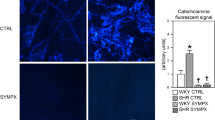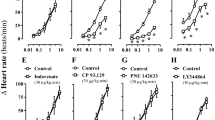Abstract
THE dopaminergic modulation of neuronal transmission in coeliac ganglia of spontaneously hypertensive rats (SHR) has been shown to be less efficient than in control Wistar Kyoto rats (WKY). From these results it was inferred that the development of hypertension may be due to this defect. Recent reports2,3 suggest that polypeptides may function as neurotransmitters or neuromodulators in sympathetic ganglia. A heterogeneous group of immunoreactive Met5-enkephalin-like (ME) peptides have been found in these ganglia3, and are also present in adrenal glands, in both chromaffin cells and afferent axons (unpublished observations). Some of these peptides, when released from the afferent axons, may modulate opiate receptors located in adrenal medulla (unpublished observations). The vasodilatory action of morphine suggests that if the opiate agonists present in the chromaffin cells were to be secreted they might also cause vasodilation by acting on distant receptors. In view of their possible role in the regulation of sympathetic transmission and vascular tone, we have studied the content and Chromatographie characteristics of the immunoreactive ME-like peptides in adrenal gland, sympathetic ganglia, salivary gland and hypothalamus of SHR and WKY rats. We report here that the content of these peptides was lower in SHR than WKY rats in all tissues studied, except the hypothalamus. In sympathetic ganglia this decrease was due to a reduction in the ME content and not to that of the high molecular weight (MW) immunoreactive ME-like peptides.
This is a preview of subscription content, access via your institution
Access options
Subscribe to this journal
Receive 51 print issues and online access
$199.00 per year
only $3.90 per issue
Buy this article
- Purchase on Springer Link
- Instant access to full article PDF
Prices may be subject to local taxes which are calculated during checkout
Similar content being viewed by others
References
Lutold, B. E., Karoum, F. & Neff, N. H. Circulation Res. (in the press).
Schultzberg, M. et al. Neuroscience 3, 1169–1186 (1978).
Di Giulio, A. M. et al. Neuropharmacology 17, 989–992 (1978).
Costa, E., Di Giulio, A., Fratta, W., Hong, J. & Yang, H.-Y.T. In Proc. 4th int. Congr. On Catecholamines (ed. Usdin, E.) (Pergamon, Oxford, in the press).
Yang, H.-Y.T., Fratta, W., Hong, J. S., Di Giulio, A. M. & Costa, E. Neuropharmacology 17, 433–438 (1978).
Eckenhoff, J. E. & Oech, S. R. Clin. Pharmac. Ther. 1. 483–524 (1960).
Gomes, C., Svensson, T. H. & Trolin, G. Naunyn Schmiedebergs Archs Pharmak. 294, 141–147 (1976).
Yang, H.-Y. T., Hong, J. S. & Costa, E. Neuropharmacology 16, 303–307 (1977).
Author information
Authors and Affiliations
Rights and permissions
About this article
Cite this article
DI GIULIO, A., YANG, HY., FRATTA, W. et al. Decreased content of immunoreactive enkephalin-like peptide in peripheral tissues of spontaneously hypertensive rats. Nature 278, 646–647 (1979). https://doi.org/10.1038/278646a0
Received:
Accepted:
Published:
Issue Date:
DOI: https://doi.org/10.1038/278646a0
This article is cited by
-
Specific opiate receptors on isolated mammalian gastric smooth muscle cells
Nature (1982)
-
Co-release of enkephalin and catecholamines from cultured adrenal chromaffin cells
Nature (1981)
-
Spontaneously (genetic) hypertensive rats: Naloxone-reversible and propranolol-reversible decrease in pain sensitivity
Experientia (1981)
Comments
By submitting a comment you agree to abide by our Terms and Community Guidelines. If you find something abusive or that does not comply with our terms or guidelines please flag it as inappropriate.



